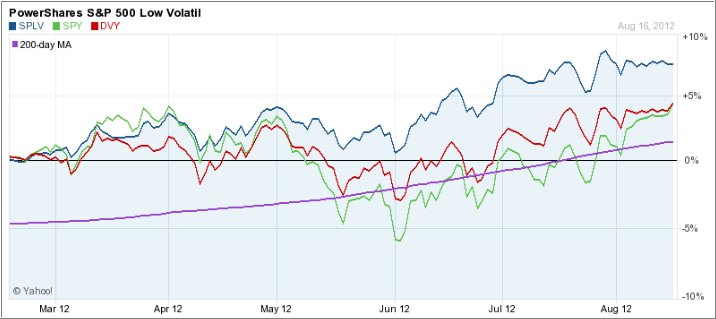If you recognize the long-term value in the S&P 500 stocks, yet are adverse to volatility, you may consider using the S&P 500 Low Volatility Portfolio (SPLV) as opposed to SPY or the broad VTI.
SPLV tracks the S&P Low Volatility Index and includes 100 stocks from the benchmark’s 500 with the lowest realized volatility over the past 12 months. If you want to maintain exposure in domestic equities without going so far as to invest in cash or Treasuries, or minimize whipsaw signals if you work with trailing stop losses, you may find SPLV attractive.
This ETF seeks to invest a minimum 90 percent of total assets in common stocks that comprise the index. The underlying index is volatility weighted and the ETF re-balances every quarter in February, May, August and November.
SPLV concentrates its investment, i.e. invests more than 25 percent or more of the value of its total assets in a single issuer to the extent that the underlying index reflects a concentration in that issuer. The fund has maximum exposures in large-cap growth, large cap value and mid-cap value stocks.
Sector wise, it has maximum exposure in utilities and consumer staples. However, the fund is extremely well diversified with holdings of individual securities ranging from 0.73 percent to 1.59 percent. Since the fund tries to replicate a benchmark, it follows a passive investment strategy and will not buy or sell a security unless that security is added or removed from the underlying index.
SPLV has returned more than 21 percent over the past twelve months versus 11.48 percent for SPY, the ETF tracking the S&P 500 Index. The fund has a 30-day SEC yield of 3.01 percent while the distribution yield is estimated at 2.95 percent.
Since most of the stocks held by SPLV are defensive sector stocks, the distribution yield is generally higher than the broad market yield. However, you should note low-volatility strategies tend to under perform the broad market in extreme bullish conditions. Since its launch in May last year, the fund has proved to be extremely popular with total assets under management approaching $2.5 billion. The fund charges 25 basis points per year.
Using an equity ETF with less volatility has its advantage when the markets churn and move not in a well defined direction. In my advisor practice, we have used predominantly DVY this year, which in similar fashion reduces volatility and has kept us in the market where more volatile ETFs like VTI triggerd our sell-stops.
Here’s a 6-month chart comparing SPY, SPLV and DVY:
[Chart courtesy of YahooFinance]Using SPY as a benchmark, you can clearly see the benfit of using less volatile ETFs. SPLV has plenty of volume and price history, and I will add it to my weekly StatSheet, both in the Master ETF list and the High Volume ETF section.
Disclosure: Holdings in DVY
Contact Ulli
